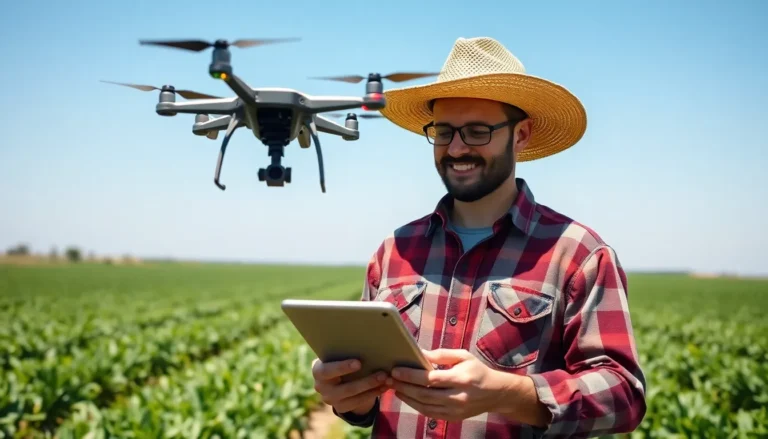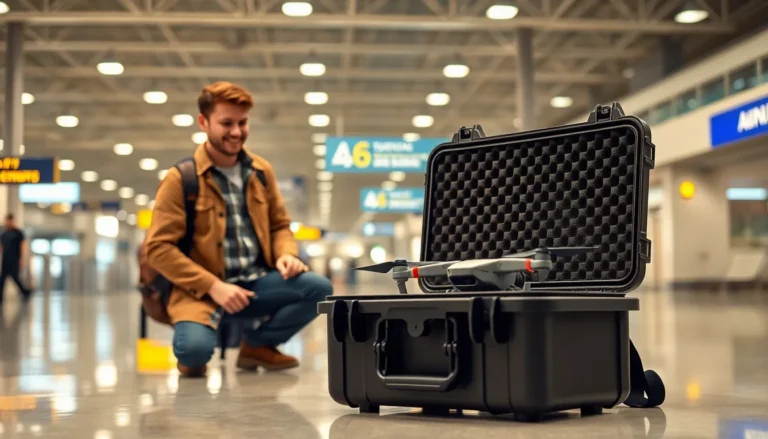Drones are buzzing overhead like pesky mosquitoes, but instead of swatting them away, people are starting to embrace this high-flying technology. From capturing stunning aerial shots to delivering pizza right to your doorstep, these flying gadgets have taken the world by storm. But what happens when they invade our personal space?
As drones zip through the skies, they raise questions about privacy, safety, and the occasional surprise photobomb. Whether you love them or loathe them, one thing’s for sure: drones are here to stay. Buckle up as we explore the fascinating world of drones flying over us and uncover the good, the bad, and the downright hilarious aspects of our new aerial companions.
Table of Contents
ToggleOverview Of Drones Flying Over Us
Drones are increasingly visible in the skies above urban and rural areas. These unmanned aerial vehicles (UAVs) operate in various capacities, from recreational use to commercial applications. Companies utilize drones for tasks such as aerial surveying, agriculture monitoring, and infrastructure inspections, showcasing their versatility.
Privacy concerns accompany the rise of drones. They can capture images and video without individuals’ knowledge. Many people express apprehension about surveillance, as drones can linger above private spaces. Federal regulations aim to address these issues by requiring drone operators to adhere to specific guidelines, including altitude limits and no-fly zones.
Safety poses additional challenges. Incidents arise when drones unintentionally collide with aircraft or enter restricted airspace. According to the Federal Aviation Administration (FAA), nearly 2,000 close encounters with manned aircraft were reported in 2020, highlighting the need for stricter regulations and awareness among drone pilots.
Public perceptions of drones vary significantly. While some view them as innovative tools enhancing everyday life, others find them intrusive. Drones’ participation in events like weddings and construction projects exemplifies their positive influence. Conversely, humorous mishaps, such as drones disrupting beachgoers or surprising wildlife, add an entertaining layer to their presence.
Organizations advocate for transparency and education within the drone industry. Educating operators about their responsibilities is crucial for fostering a safe environment. Communities benefit from understanding drone technology and its implications, promoting balanced coexistence between airspace users.
Impacts On Privacy
Drones raise significant privacy concerns as they become more prevalent in everyday life. Their ability to capture images and videos without prior consent leads to apprehension among individuals regarding surveillance.
Surveillance Concerns
Surveillance poses a primary challenge linked to drone activity. Many people feel uneasy knowing these devices can record their movements without any awareness. Various studies indicate an increase in unfounded surveillance fears, particularly in urban settings where drones buzz overhead. Regulatory frameworks are slowly adapting to these changing technologies, yet the gap between legislation and public expectations remains broad. Increased pressure from civil rights organizations highlights the need for clearer policies and greater accountability among drone operators.
Data Collection Issues
Data collection opens another avenue for privacy infringement. Drones can gather personal data, triggering fears of misuse or unauthorized access. Numerous instances have emerged where drone footage unintentionally captures sensitive information, such as license plates or personal property. The potential for data breaches raises alarms about how collected information might be stored or shared. Strict measures, such as data protection laws, are essential for safeguarding individuals’ privacy rights against unauthorized surveillance and data collection practices.
Benefits Of Drones Flying Over Us
Drones flying overhead offer numerous advantages across various sectors, enhancing efficiency and safety. Their roles in emergency situations and commercial applications significantly shape current practices.
Emergency Response And Disaster Relief
Drones improve emergency response times. They provide real-time aerial views during natural disasters, enabling rescue teams to assess situations quickly. Drones can deliver essential supplies like medical kits to hard-to-reach areas. Efficient mapping capabilities support search operations for missing persons. During wildfires, drones monitor fire spread and gather data to optimize containment strategies. These advantages prove invaluable in saving lives and minimizing damage.
Commercial Uses In Agriculture And Delivery
Drones have revolutionized agriculture practices. They enable farmers to monitor crop health with precision and provide insights on irrigation needs. Drones can spray pesticides evenly, reducing chemical use and increasing yield. In the delivery sector, drones streamline logistics for businesses. Food delivery systems have embraced drones to ensure fast and efficient service, reducing wait times for customers. Companies like Amazon actively test drone delivery, showcasing the potential to transform shipping methods. Combining these applications establishes drones as essential tools for modern commerce.
Regulations And Compliance
Regulations surrounding drones play a crucial role in ensuring safety and privacy. As drone usage increases, understanding current legislation becomes essential.
Current Legislation
The Federal Aviation Administration (FAA) oversees drone regulations in the United States. Current rules require drone operators to register their devices if they weigh more than 0.55 pounds. Operators must adhere to the guidelines for flying below 400 feet and maintain visual line of sight. Specific restrictions apply to flying near airports and over people. Additionally, many states have laws targeting drone surveillance and personal privacy, setting limitations on recording individuals without consent. Compliance with these regulations not only promotes safe operations but also addresses public concerns about privacy and security.
Future Policies
Future policies aim to adapt to the rapidly evolving drone landscape. The FAA is actively working on integrating drones into the national airspace system. Proposed measures include remote identification for all drones, enhancing accountability among operators. Increased collaboration with technology stakeholders may lead to more comprehensive regulations, incorporating evolving safety standards. Public input will guide policymakers in creating rules that balance innovation with public safety. Trends suggest that stricter enforcement of privacy guidelines could emerge, promoting greater transparency and operator responsibility. MQTT standards could also shape future compliance requirements, ensuring drone technology remains safe and user-friendly.
Public Perception And Acceptance
Public perception of drones varies significantly across communities. Some individuals embrace drones as innovative and beneficial technologies, enhancing everyday experiences. Others express concerns about privacy and surveillance, feeling uneasy about being recorded without their consent. Many people voice worries about unauthorized data collection, leading to a demand for stronger privacy protections.
Acceptance of drones often hinges on their applications. Aerial photography and agricultural monitoring garner positive responses due to their evident benefits. In contrast, instances of drones capturing sensitive information lead to apprehension. Reports of near collisions and unauthorized flights increase anxiety surrounding safety.
Regulatory frameworks aim to address public concerns, yet gaps remain. The Federal Aviation Administration (FAA) seeks to implement guidelines that balance innovation and safety. Recent statistics show nearly 2,000 reported close calls with manned aircraft in 2020, emphasizing the urgency for stricter regulations.
Education contributes to shaping public attitudes toward drones. With increased understanding, communities may recognize the responsible uses of drones in emergency response and logistics. Positive stories from drone-assisted search operations in missing person cases and food delivery services highlight their potential benefits.
Transparency from operators plays a crucial role in easing public apprehension. Organizations advocate for clear communication regarding data collection practices and operator responsibilities. Engaging with the community fosters trust and acceptance among residents.
Awareness campaigns can also promote understanding of drone technology. Many individuals benefit from learning about the safety measures in place, such as registration requirements for devices over 0.55 pounds. When stakeholders collaborate, they create a more informed public that can contribute thoughtfully to ongoing discussions about drone operations.
Drones are undeniably becoming a significant part of daily life. Their versatility and potential for innovation are reshaping various industries. However the concerns surrounding privacy and safety cannot be overlooked. As technology continues to evolve the need for clear regulations and public education becomes increasingly important.
Balancing the benefits of drones with public apprehensions will require ongoing dialogue between operators regulators and communities. As society adapts to this aerial presence understanding the implications of drone use will be essential for fostering trust and ensuring responsible operation. Drones may be here to stay but how they’re integrated into daily life will depend on collective efforts to address the challenges they present.





